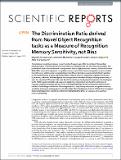Files in this item
The discrimination ratio derived from novel object recognition tasks as a measure of recognition memory sensitivity, not bias
Item metadata
| dc.contributor.author | Sivakumaran, Magali H. | |
| dc.contributor.author | MacKenzie, Andrew K. | |
| dc.contributor.author | Callan, Imogen R. | |
| dc.contributor.author | Ainge, James A. | |
| dc.contributor.author | O'Connor, Akira R. | |
| dc.date.accessioned | 2018-08-02T08:30:08Z | |
| dc.date.available | 2018-08-02T08:30:08Z | |
| dc.date.issued | 2018-08-01 | |
| dc.identifier | 255031176 | |
| dc.identifier | 5b629e09-980b-4899-a5d3-552bea4041c0 | |
| dc.identifier | 85050994577 | |
| dc.identifier | 000440412400001 | |
| dc.identifier.citation | Sivakumaran , M H , MacKenzie , A K , Callan , I R , Ainge , J A & O'Connor , A R 2018 , ' The discrimination ratio derived from novel object recognition tasks as a measure of recognition memory sensitivity, not bias ' , Scientific Reports , vol. 8 , 11579 . https://doi.org/10.1038/s41598-018-30030-7 | en |
| dc.identifier.issn | 2045-2322 | |
| dc.identifier.other | ORCID: /0000-0002-7943-5183/work/47136383 | |
| dc.identifier.other | ORCID: /0000-0002-0007-1533/work/60428120 | |
| dc.identifier.uri | https://hdl.handle.net/10023/15749 | |
| dc.description | This work was supported by the Biotechnology and Biological Sciences Research Council UK (BBSRC) under the EastBio doctoral training program [grant number BB/J01446X/1]. | en |
| dc.description.abstract | Translational recognition memory research makes frequent use of the Novel Object Recognition (NOR) paradigm in which animals are simultaneously presented with one new and one old object. The preferential exploration of the new as compared to the old object produces a metric, the Discrimination Ratio (DR), assumed to represent recognition memory sensitivity. Human recognition memory studies typically assess performance using signal detection theory derived measures; sensitivity (d′) and bias (c). How DR relates to d′ and c and whether they measure the same underlying cognitive mechanism is, however, unknown. We investigated the correspondence between DR (eye-tracking-determined), d′ and c in a sample of 37 humans. We used dwell times during a visual paired comparison task (analogous to the NOR) to determine DR, and a separate single item recognition task to derive estimates of response sensitivity and bias. DR was found to be significantly positively correlated to sensitivity but not bias. Our findings confirm that DR corresponds to d′, the primary measure of recognition memory sensitivity in humans, and appears not to reflect bias. These findings are the first of their kind to suggest that animal researchers should be confident in interpreting the DR as an analogue of recognition memory sensitivity. | |
| dc.format.extent | 1322520 | |
| dc.language.iso | eng | |
| dc.relation.ispartof | Scientific Reports | en |
| dc.subject | BF Psychology | en |
| dc.subject | NDAS | en |
| dc.subject.lcc | BF | en |
| dc.title | The discrimination ratio derived from novel object recognition tasks as a measure of recognition memory sensitivity, not bias | en |
| dc.type | Journal article | en |
| dc.contributor.institution | University of St Andrews. Institute of Behavioural and Neural Sciences | en |
| dc.contributor.institution | University of St Andrews. School of Psychology and Neuroscience | en |
| dc.identifier.doi | https://doi.org/10.1038/s41598-018-30030-7 | |
| dc.description.status | Peer reviewed | en |
This item appears in the following Collection(s)
Items in the St Andrews Research Repository are protected by copyright, with all rights reserved, unless otherwise indicated.

